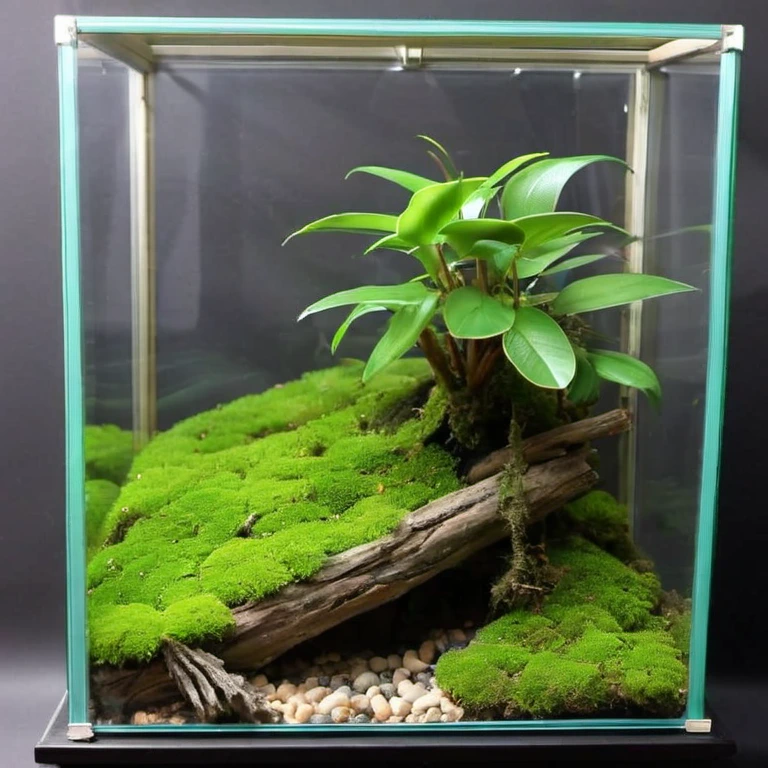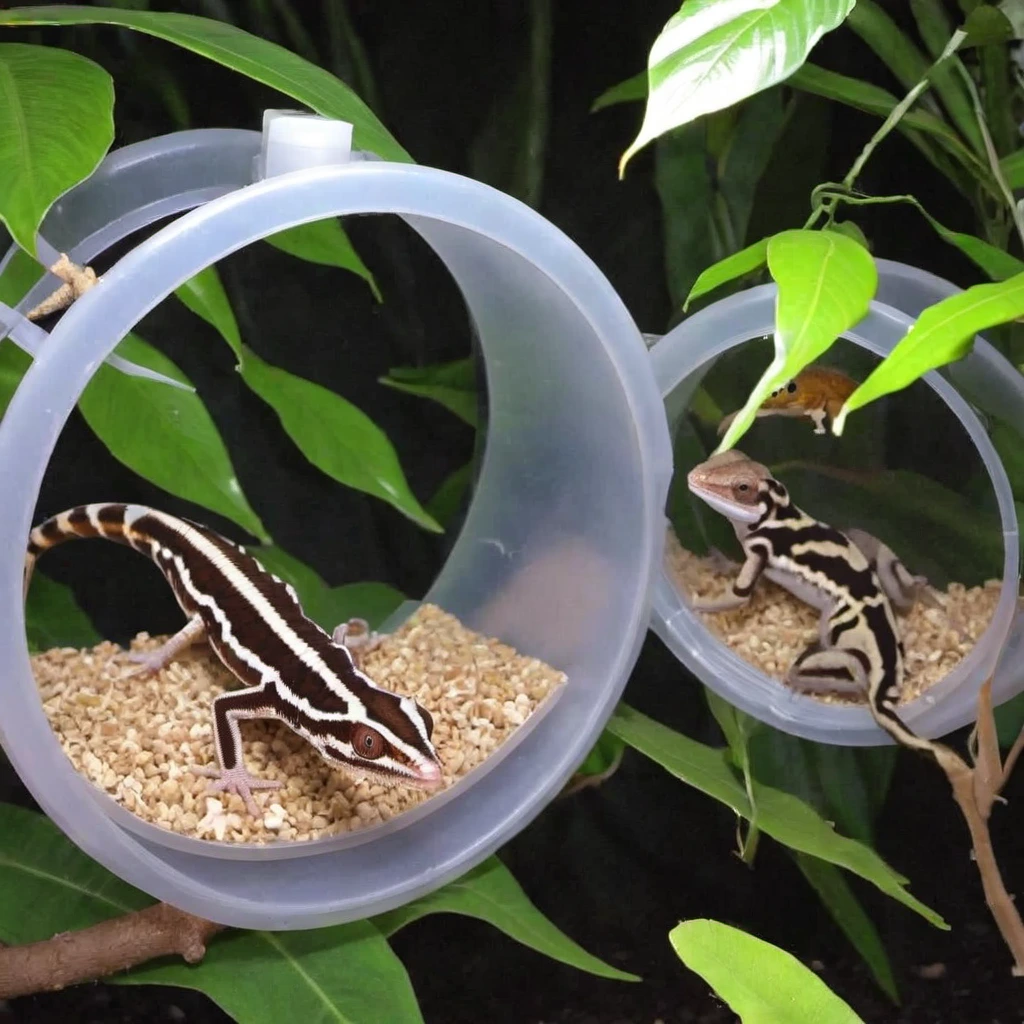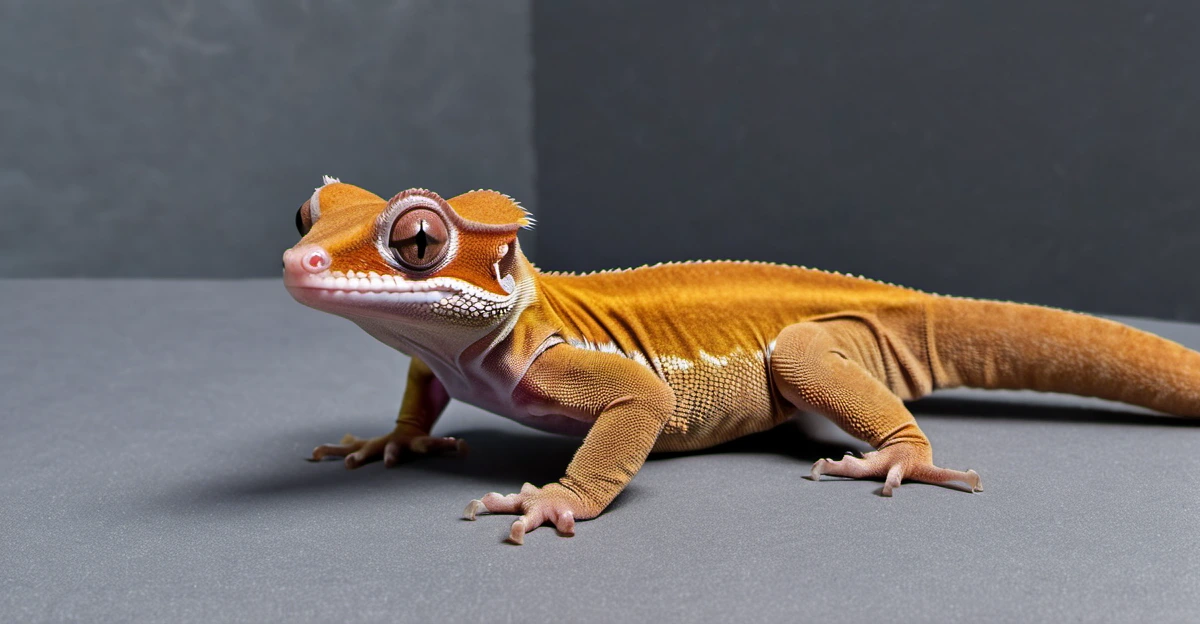
Crested geckos have captivated reptile enthusiasts as an easy-to-care-for lizard ideal for beginners and expert herpers alike, as outlined in detailed crested gecko care guides. When it comes to housing these popular pet reptiles, a frequently asked question is: can crested geckos live together? peacefully in the same enclosure?
The answer depends on several factors regarding the specific geckos, habitat conditions, density, and proper introductions we will cover in this article:
- Gender of the crested geckos
- Age and size differences
- Enclosure considerations
- Density of geckos for space
- Resources needed
- Potential stress and signs of aggression
- Quarantine period
- Proper introductions
Equipped with this information, you can make an informed decision on whether a communal crested gecko habitat is right for your reptiles. Every situation presents unique considerations regarding the wellbeing of keeping crested geckos together.
Crested Gecko Habitat Requirements
In their native tropical forest habitat of southern New Caledonia, crested geckos are arboreal tree dwellers that come down to the rainforest floor infrequently. These lizards utilize vertical space and thrive with foliage density in close canopy proximity. When planning any captive habitat for pet crested geckos – whether housing them alone or with other geckos – it is essential their enclosure meets key environmental requirements:
Humidity
Crested geckos do best at average humidity levels between 50-80%. Drops in humidity can lead to respiratory stress, compromised immunity, and improper shedding. Humidity also impacts egg incubation for breeding crested geckos. Various methods can raise humidity depending on habitat size from misting systems, hand misting, hydro-polymer substrates, and evaporative water layers.

Temperature
Ideal temperatures for crested geckos range from 65-80 °F primarily, with a warm basking zone between 80-85° provided. Low spikes below 65° can cause health issues. Reliable heating and lighting devices are necessary to establish a proper temperature gradient across the terrarium
Hide Spots
A variety of hiding spots located across temperature zones allows each crested gecko a secure, shaded refuge for sleeping and retreating in comfort. This greatly reduces stress and aggression when housed communally. Multiple magnaturals cork tubes, artificial foliage, bark slabs, mini caves all make excellent hide options. Having 2-3 quality hiding spaces per individual crested gecko prevents unnecessary competition.
Enclosure

Size These arboreal lizards require more vertical space than floor space. General guidelines for crested gecko enthusiasts suggest a minimum of an 18 x 18 x 24” tall vivarium for one adult gecko. This allows for ample movement, exploring enrichment, and designated activity zones. Juvenile geckos can start in 12 x 12 x 18” enclosures.
When housing crested geckos together, size requirements must increase depending on number of inhabitants sharing the habitat. A good rule of thumb is at least 18 x 18 x 24” of space for every 2-3 crested geckos for healthy cohabitation regarding territory and access to essential environmental resources outlined.
Climbing Features
Given their innate arboreal nature, ample climbing opportunities spanning horizontal and vertical space makes for happy, enriched crested geckos whether solitary or paired. Natural branches, hanging vines, cork rounds, and broad leaf artificial foliage offer terrestrial to fully upright climbing and basking needs.
Substrate
Proper substrate helps maintain ambient humidity while allowing easy spot cleaning waste and leftover feedings in a bioactive planted vivarium habitat for communal crested geckos. Peat moss, sustainably harvested mosses, coconut fiber, and orchid bark substrates work well. 3-4” of substrate depth allows burrowing enrichment.
Feeding Stations
With insects and cubed fruit making up ideal crested gecko diet components, separated feeding stations prevent resource guarding aggression. Multiple feeding ledges, dishes, and even Terminalia branches positioned all around the habitat grants each resident access during meal times.
Thoroughly cleaning the entire habitat between main feedings reduces waste buildup and microorganisms that could be transmitted between crested geckos. Replace substrates and disinfect décor items regularly.

Water Sources
Multiple fresh water sources available at all times prevents resource competition. Shallow dishes on low set floors alongside higher climbing space dishes ensures individual crested geckos remain properly hydrated. Misting habitats by hand or with misting systems also supplements ambient hydration via water droplets.
Ambient Habitat
Lighting While specialized heating and UVB light devices should be applied selectively just during daytime/early evening activity hours for 10-12 hours, low level ambient lighting enables crested geckos to maintain a healthy circadian rhythm and behavior when housed together. Moonlight or twilight bulbs, red bulbs, or low wattage Ceramic Heat Emitters (CHE) keep ambient light 24/7.
When introducing multiple crested geckos, ample spacing and resources allows individuals to assess territorial limits comfortably and find their spot peacefully, reducing chances for aggression and stress. Now let’s explore the considerations around compatible crested geckos to house together after their habitat environment is fully prepared and stabilized.
What is The Ideal Number of Crested Geckos Per Enclosure?
Determining exactly how many crested geckos can coexist happily in a given environment depends firstly on the size of their habitat space. Generally two to three adult crested geckos is reasonable for an average 18 x 18 x 24” tall vivarium as outlined above. Less individuals is advised for smaller juvenile habitats specifically to accommodate their frequent shedding and rapid growth spurts.
However, even with adequate physical space meeting all hides, climbing routes, feeding zones, etc. – individual temperaments must be accounted for. Starting with just a male/female bonded pair even in a very large custom enclosure makes sense before testing capacity for larger colonies. Some personalities simply prefer solitary accommodations. Knowing signs of stress is crucial. Expand territories gradually after prolonged periods lacking any aggression or avoidance behaviors.
Observe over days and weeks before assuming safely houseable numbers – slow acclimations prevent disasters. Density experiments should focus on animal health metrics first – not how many crested geckos you can possibly cram inside equal cubic space capacity. Account for substantial separate territorial zones.
Can You House Male and Female Crested Geckos Together?
One of the most common questions around cohabitating crested geckos is if males and females can share an enclosure safely long-term. The answer is yes they potentially can, but breeding behaviors must be considered closely. Some key factors include:
Breeding Frequency Concerns
- Females reach sexual maturity between 12-18 months old once over 30 grams bodyweight.
- Males mature slightly faster at 6-12 months when exceeding 25 grams.
- Egg production from breeding stresses female geckos consuming much energy and calcium.
- Ideal egg laying frequency is 4-6 times annually maximum for female health.
- Ongoing breeding can jeopardize female bone density without calcium rest periods.
Unwanted Egg Laying and Offspring
Continuous breeding cycles may occur keeping male and female adult crested geckos together permanently unless:
- Temperatures are kept below 65° F to curb mating instincts.
- Separate male before eggs develop, incubate/freeze eggs humanely.
- Account for larger habitat to comfortably raise offspring long-term or have adoption plans.
Territorial Changes and Aggression
- Gravid female crested geckos seek increased seclusion before egg laying.
- Oviposition sites spark territorial standoffs occasionally.
- Male competition for mating opportunities happens on rarer occasion.
- Personality clashes or food resource guarding are always possibilities too.
Solutions exist to balance healthy breeding and boundaries. But know signs of stress and have backup enclosures in case conflict remains frequent. Females should have sizable egg laying zones and males diverted before eggs fully develop if raising offspring is not the goal. Quality habitat space and resources easing tensions are key housing crested geckos together.
Can Crested Geckos of Different Sizes and Ages Cohabitate?
When it comes to variances in individual resident ages, sizes, and stages of development – additional considerations come into play housing crested geckos together:
Large Size
Disparities A substantial 40 gram adult male crested gecko paired with a recently matured 20 gram female or subadult gecko can present problems even with enough territory space. The sheer difference in size poses safety risks and intimidation. Be cautious cohabitating any specimen double or triple the overall body mass of another.
Juveniles and Hatchlings
Baby crested geckos and juveniles up to 1 year old likely should never be housed with larger mature adults. The tiny geckos become incredibly stressed and can be bullied relentlessly. They also require very different care routines regarding feeding, supplementation, and environmental factors like heat gradients.
Introducing subadults around 20-25 grams with weights within 10 grams of an existing adult gecko resident has potential assuming ample added space. But size differences can still enable harmful bullying. Know that subadults irritate adults sometimes as rambunctious troublemakers.
Seniors and Special Needs
Elderly crested geckos with health issues should always be separated into ideal solitary enclosures fitting their condition. Arthritis, early organ decline, or metabolic bone disease may make shared habitat navigation difficult. Recovery routines require focused resource allotments without competition.
The same goes for any geckos with cleared protozoa infections, recessive neurological conditions, tail nips, or other impairments. Stress negatively impacts immune function and aggravates symptoms. Single accommodations, supplement boosts, feeder insect variety all better serve their rehabilitation.
Ultimately pairing crested geckos by nearly identical size and age within a few months range as juveniles raised communally from hatching offers the smoothest success transitioning them into a spacious adult enclosure. But gradual staged introductions must be made still at each phase weighing factors like personality traits and breeding behaviors discussed.
Do Crested Geckos Get Stressed Sharing an Enclosure?
Ensuring minimal stress is crucial to responsible reptile care for any species. Though durable and fairly resilient, prolonged stress jeopardizes crested gecko health and wellness over time:
- Appetite and Diet changes
- Activity and Sleeping routine disruptions
- Skin discoloration and Shedding difficulty
- Slowed growth rates
- Tail loss from frequent retreats
- Lowered immunity factors
Crested geckos are not extremely social or colony-dwelling by nature outside mating periods. While they may tolerate some stable cohabitation given the considerations covered, solitary living often proves most prospering long-term regarding behavior enrichment and activity consistency measured against perceived stress reactions.
Observe them closely for signs listed above across days and weeks. Try introductions when young and be ready to separate. Stress related illness can be prevented when managed early.
Do Crested Geckos Show Aggression Toward One Another?
Healthy aggression around breeding competition and defending territory exists absent harm especially among male crested geckos. However, overt violence involving:
- Lunging charges ending in attack
- Biting limbs or tails
- Repeated ramming during hide disputes
- Sustained hostile pursuit
Are all immediate red flags to separate fighting geckos at minimum into a reintroduction transition enclosure. But long-lasting personality clashes likely warrant permanent solitary living accommodations without risks of repeat altercations.
Not all species thrive communally. And some crested geckos simply prefer being the sole enclosure inhabitant despite age or gender and ample habitat resources. Know when aggressive tendencies are simply not manageable.
Can Different Crested Gecko Morphs Live Together?
While color and pattern morphs do not inherently prevent successful communal grouping, slight size variances between some crested gecko morph lineages should be considered. For example:
Larger Morph Examples
- Raptors tend to reach 45-65 grams quite frequently.
- Crocodile morphs also eclipse 50+ grams.
- Chahoua morphs derived from the closely related New Caledonia species range heavier.
Smaller Morph Examples
- Harlequins are often petite below 40 grams lifelong.
- Dark red flame lineages range 30-45 grams.
- Certain striped variants hatch smaller more delicately.
These are just general baseline averages. But being aware of potential adult size gaps expected relative to common genetic mutations keeps perspective housing different morphs together. A 60 gram Raptor male may bully smaller striped or Harlequin females for instance.
Adhere to gradual introductions and personality testing between morphs with some size disparities particularly. Temperament still varies individually across mutations. Slower acclimations prevent disasters and assumptions.
Do Crested Geckos Need A Quarantine Period Before Introductions?
Whenever introducing multiple new crested geckos simultaneously to an existing enclosure habitat, thorough individual quarantine periods are highly suggested prior:
- Minimum 30-45 day quarantines in separate simple enclosures
- Multiple fecal tests for parasites every two weeks
- Checks for early signs of crypto or adenovirus
- Body condition and appetite evaluations
- Supplemental regime to balance nutrition
- Survey for mites or external pathogens
These quarantines enable complete health evaluations ensuring no illnesses transmit throughout entire collections or jeopardize other fragile rescues. It also grants adjustment settling to monitor basic behavior.

After passing comprehensive health inspections post-quarantine and meeting handling criteria, controlled scheduled introductions to the now vacant multi-gecko setup can begin one crested gecko at a time every 72 hours. Allow at least 2 weeks before attempting any pairings after the last gecko is introduced to promote secure environmental acclimation absent added disruptions.
What is The Best Way to Introduce New Crested Geckos?
Gradual dedicated introductions prevent most disasters housing crested geckos together once fully quarantined additions arrive into a newly cleaned main habitat after removing previous occupants. Brief scheduled weekly interactions across barriers are key stepping stones. Using temporary dividers allows gradual sensory adjustments:
Week 1) Olfactory Introduction
Scent exchange from opposite mesh divider for 30-60 minutes breeds assessment familiarity. Thorough multi-point wipe downs with paper towels freshen the habitat eliminating traces between reintroductions. Repeat encounters 2-3 times week one.
Week 2) Visual Introduction
A clear glass or plastic temporary divider lets 23 hour visual contact except during 1 hour supervised encounters testing reactions. Good results enable divider removal leading to final direct contact stage.
Week 3) Physical Introduction
Fully protective presence to referee initial direct floor time interactions looking for signs of immediate aggression or stress. Have backup enclosures and sterile transport containers ready just in case. With positive receptions, combine to full habitat.
Keep alert complete first month cohabited for any emerging issues like feeding disputes or nighttime altercations sometimes missed. Be ready to separate permanent pairs, trios, or colonies if conflicts reemerge continuously compromising welfare. Having backup solo enclosures always helps transitions.
In Conclusion – Potential for Compatibility Ultimately when carefully balancing all the discussed variables thoroughly from habitat resources and structure to age, gender, morph and health statuses assessed through gradual peer introductions during quarantines – some to most captive crested geckos can find sustainable community living given vigilance. But exceptions frequently exist too.
Not all personalities mesh communally, so observe reactions closely. Never assume group housing will ultimately work by any rule of thumb. Monitor for stress signals regularly in a proactive preventative manner. Solitary provisions may still prove necessary long-term benefiting particular crested gecko wellbeing. Prioritize individuals over our aesthetic assumptions for community spaces.
For further information on ideal crested gecko specialized care, handling, and husbandry for every unique situation, review our crested gecko care sheet and other related articles to make the most informed decisions related to your pet’s health and happiness. Environmental fine-tuning guided by their behaviors day-to-day leads to profound bonds with these remarkable reptiles full of personality
Expanded Housing
Considerations for Communal Crested Geckos While the previous sections covered core habitat provisions and introductions for housing crested geckos together, additional enclosure enrichments and setup factors further promote healthy communities by reducing tension through sensory stimulation and opportunities for individualized retreats.
Visual Barriers
Translucent plant foliage, cork slabs, and bamboo sticks positioning throughout the habitat act as intermittent visual barriers. Allowing the crested geckos periods of partial vision obstruction while retaining their overall sense of security helps prevent perceived encroachment from cohabitors continually in direct line of sight. These restless lizards benefit from a subtle sense of illusion that their territory expands behind cover.
Textured Zones
Incorporating a variety of naturalistic substrate textures across floor space zones not only aids essential humidity retention for proper shedding and respiration based on crested gecko specialized requirements – the variety and choices allow individual geckos control. Smooth river rock plates bordering the soft leaf litter enclosure edge varied by patches of reptile carpet and sphagnum moss towards the center all bring sensory enrichments. The diversity grants freedom to choose their preferred surface for any given activity from feeding, to sleeping, to exercising at will.
Auditory Enrichments
While we often focus sights, smells, climbs and touches enriching crested gecko enclosures suitably, sometimes subtle audible elements get overlooked for communal integration success. Gentle water features like corner mounted dripping filters or recirculating fountains make soothing babbling that serves masking ambient noise disturbances. Mixing various sizes of river pebbles lining the water and hardscape features adds organic percussion. Chimes hung offering slight breeze interaction completes the audio profile for increased home dynamic tranquility.
Transition Zones
Another fundamental enrichment for any crested gecko habitat but particularly multiples sharing tighter quarters are transition zones allowing gradual acclimation between environmental changes. Reptiles prefer moderate graduations moving between light ranges, humidity shifts from mist cycles, and temperature gradients day and night. Rock wall dividers, potted plants on corner shelves, and partial cloth canopy covers enable crested geckos fluid transitional choices. This grants each animal increased autonomy reducing stress.
Emergency Isolation Areas
While consistent monitoring for signs of aggression or discomfort remains essential when introducing and maintaining crested geckos together in community habitats long-term, providing emergency isolation areas within the enclosure optimizes reactive interventions.
Small lockable cages secured inside the habitat act as temporary individual separation fixtures in the event disagreements escalate suddenly despite the other provisions detailed. This ready holding cell on standby to remove the stressed occupant rapidly for assessment allows quarantine determination next steps defusing the situation without further disruption. Ideal isolation cages have proper heating gradients and humble decor.
The collective enrichments covered help facilitate a comforting, stimulating environment with choice that any communal crested geckos lucky to share appreciate. Take advantage of vertical space climbing opportunities through aerial runways. Bring natural sights, smells and sounds indoors through planted decor, misters and audio accoutrements.
Texture territories granting free will movement on their preferred surfaces. Establish flexible sightline barriers and transitional lighting gradients between designated spaces maximizing exposure control. And have emergency response quarantine cages afforded inside when rare but serious disputes mandate immediate medically-focused holding assessments.
Revisit our comprehensive housing, handling, feeding and overall husbandry guide for expanded insight into ideal habitat provisions specific to crested gecko species flourishing. Health and behavioral wellness day-to-day directly ties to the quality of controlled captive environment and resources we creatively architect for these remarkable lizards to thrive both independently or together cautiously in community.
Promoting safety first through cage spatial considerations and staggered introductions allows determining which creatures tolerate cohabitation compatibly long-term.
You can also check some other information on wiki for crested geckos.
